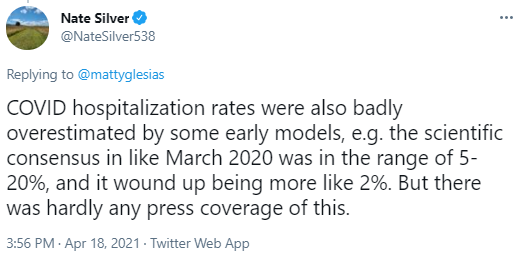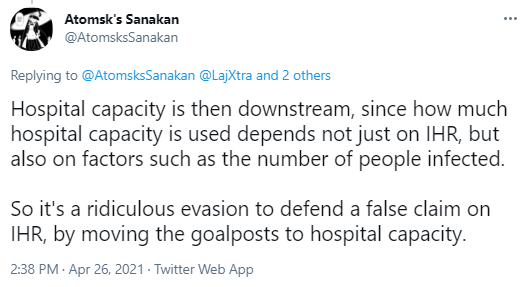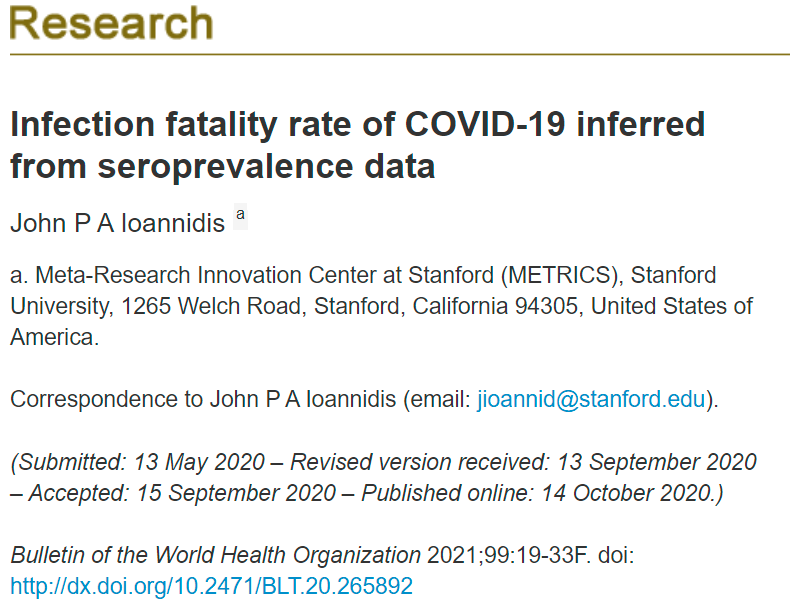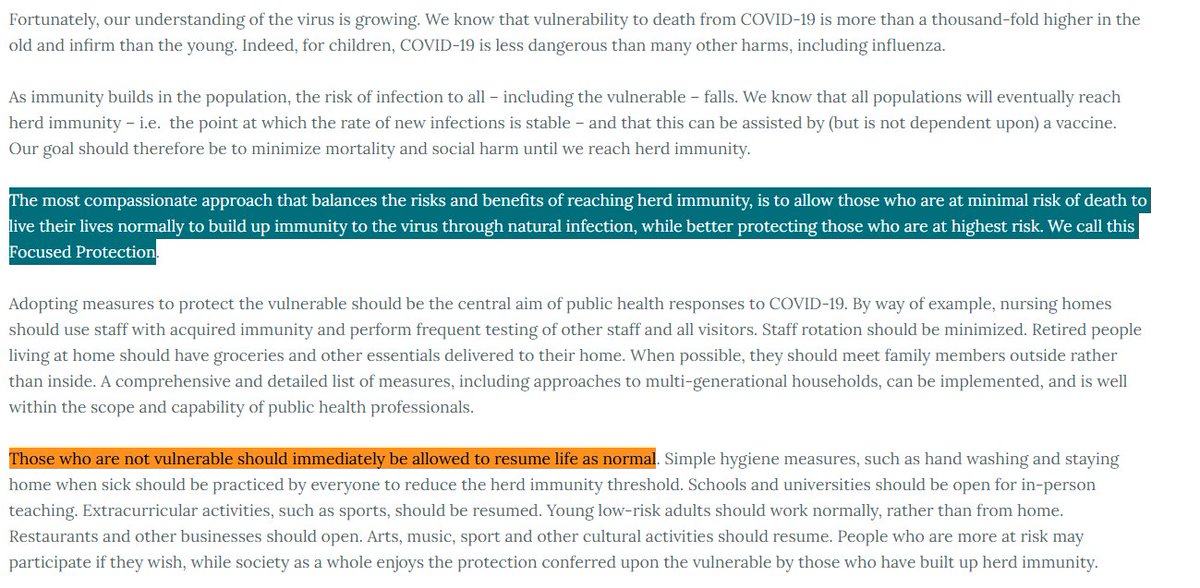
1/Y
Many criticized the article below co-authored by Jay Bhattacharya, who also co-wrote the Great Barrington Declaration.
But I haven't seen a detailed explanation of why the article was wrong + dangerous. So I'll give one here
theprint.in/opinion/majori…
Many criticized the article below co-authored by Jay Bhattacharya, who also co-wrote the Great Barrington Declaration.
But I haven't seen a detailed explanation of why the article was wrong + dangerous. So I'll give one here
https://twitter.com/AtomsksSanakan/status/891040491214688257
theprint.in/opinion/majori…

2/Y
It was clear Bhattacharya + others were wrong long before the recent resurgence of COVID-19 in India.
So this is not just "hindsight is 20/20."
archive.is/wxqye#selectio…
[judithcurry.com/2021/01/10/cov…]

It was clear Bhattacharya + others were wrong long before the recent resurgence of COVID-19 in India.
So this is not just "hindsight is 20/20."
https://twitter.com/AtomsksSanakan/status/1359626586283249665
https://twitter.com/AtomsksSanakan/status/1321948456261455875
archive.is/wxqye#selectio…
[judithcurry.com/2021/01/10/cov…]
https://twitter.com/AtomsksSanakan/status/1339705542227464192
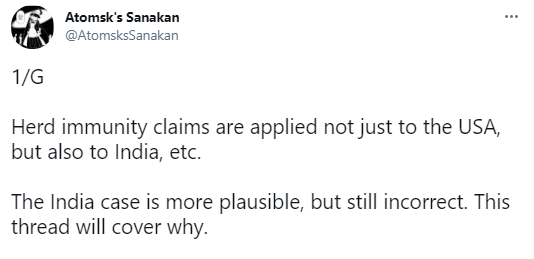
3/Y
Imagine the spread of SARS-CoV-2 as an accelerating car.
Some brakes help slow the car, such as masks, social distancing, contract tracing, etc.
But even without brakes, the car will eventually start slowing down on its own; that's herd immunity.
Imagine the spread of SARS-CoV-2 as an accelerating car.
Some brakes help slow the car, such as masks, social distancing, contract tracing, etc.
But even without brakes, the car will eventually start slowing down on its own; that's herd immunity.
https://twitter.com/AtomsksSanakan/status/1337238156052226050
4/Y
Once you have enough people immune to infection at herd immunity (whether immune by prior infection or vaccination), you can stop using the brakes and the car still won't accelerate.
Bad idea to release the brakes too early without herd immunity.

Once you have enough people immune to infection at herd immunity (whether immune by prior infection or vaccination), you can stop using the brakes and the car still won't accelerate.
Bad idea to release the brakes too early without herd immunity.
https://twitter.com/AtomsksSanakan/status/1353149506943070208
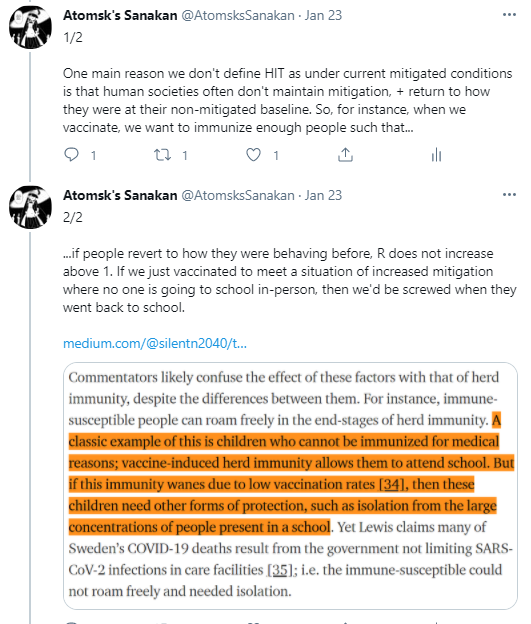
5/Y
Bhattacharya doesn't like various brakes for ideological reasons (there's a reason he goes to right-wing outlets a lot).
So he exaggerated how close India was to herd immunity.
"a near majority of the population has developed immunity to the virus"
theprint.in/opinion/majori…
Bhattacharya doesn't like various brakes for ideological reasons (there's a reason he goes to right-wing outlets a lot).
So he exaggerated how close India was to herd immunity.
"a near majority of the population has developed immunity to the virus"
theprint.in/opinion/majori…
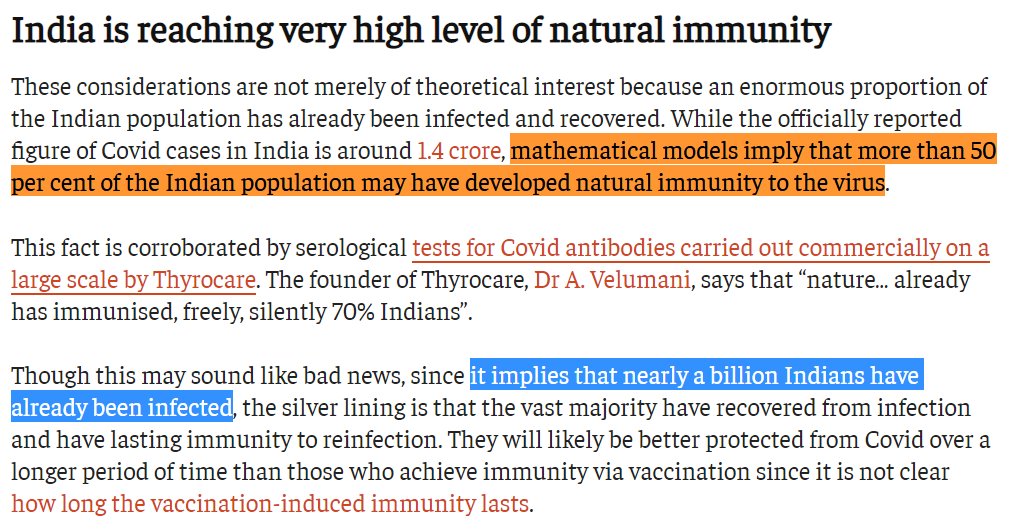
6/Y
That's consistent with Bhattacharya exaggerating the number of infections for over a year.
It's convenient for him in a number of ways, such as allowing him to give COVID-19 fatality rates so low they're impossible.
archive.is/QLmJt#selectio…
That's consistent with Bhattacharya exaggerating the number of infections for over a year.
It's convenient for him in a number of ways, such as allowing him to give COVID-19 fatality rates so low they're impossible.
https://twitter.com/AtomsksSanakan/status/1363988291335380992
archive.is/QLmJt#selectio…
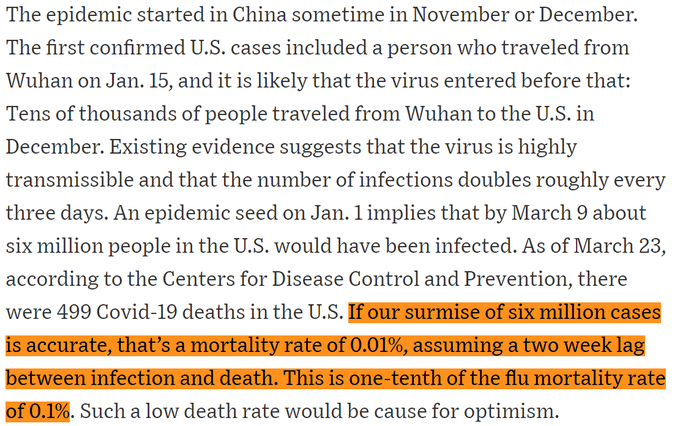
7/Y
Bhattacharya accepts models when they're convenient for his ideology, + ditches them otherwise. He mixed that with his usual bad extrapolations from non-representative samples.
Anyway, India was nowhere near ~50% of their population being infected.
papers.ssrn.com/sol3/papers.cf…
Bhattacharya accepts models when they're convenient for his ideology, + ditches them otherwise. He mixed that with his usual bad extrapolations from non-representative samples.
Anyway, India was nowhere near ~50% of their population being infected.
papers.ssrn.com/sol3/papers.cf…
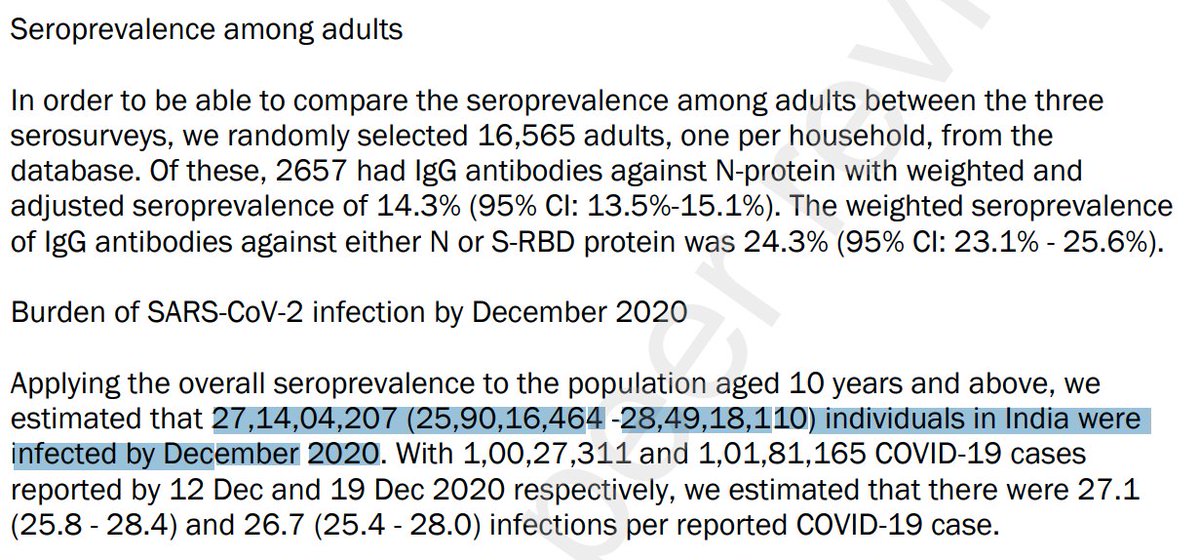
8/Y
So the car is facing the edge of the cliff.
Bhattacharya (falsely) tells the driver they are very close to not needing the brakes anymore to slow down the car.
What could be worse than that?
Well... Bhattacharya telling them brakes don't work. 🤦♂️
theprint.in/opinion/majori…
So the car is facing the edge of the cliff.
Bhattacharya (falsely) tells the driver they are very close to not needing the brakes anymore to slow down the car.
What could be worse than that?
Well... Bhattacharya telling them brakes don't work. 🤦♂️
theprint.in/opinion/majori…
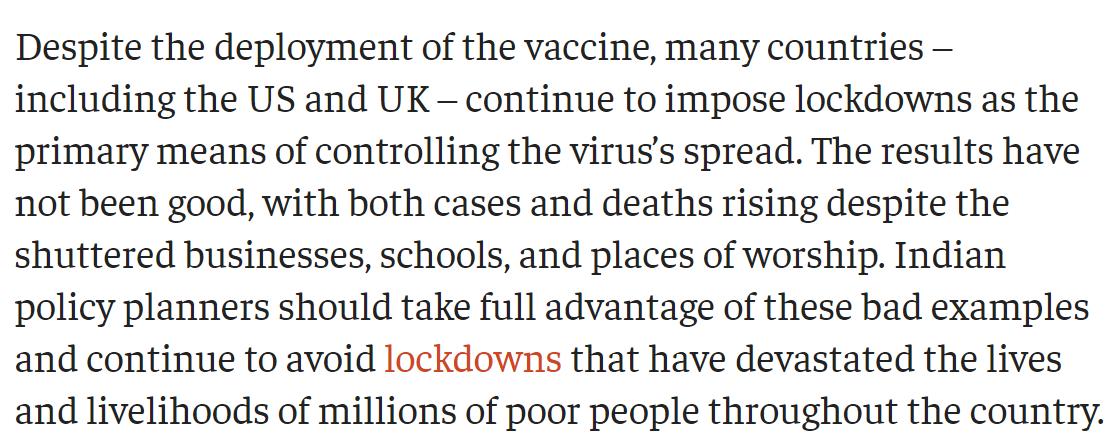
9/Y
I'm not going to rehash the reasons why limiting people being near each other limits transmission of a virus that spreads by people being near each other.
Not like Bhattacharya + his fans will learn at this point anyway.
I'm not going to rehash the reasons why limiting people being near each other limits transmission of a virus that spreads by people being near each other.
Not like Bhattacharya + his fans will learn at this point anyway.
https://twitter.com/AtomsksSanakan/status/1364648060584919048
https://twitter.com/GidMK/status/1371045429232631810
10/Y
One of Bhattacharya's proposed solutions is to reserve vaccinations for people who were not infected before.
That would be an interesting point,... except that he can't help but add to that his distortions of immunology and vaccines.
theprint.in/opinion/majori…
One of Bhattacharya's proposed solutions is to reserve vaccinations for people who were not infected before.
That would be an interesting point,... except that he can't help but add to that his distortions of immunology and vaccines.
theprint.in/opinion/majori…

11/Y
There's good reason to think that vaccines will work better than "natural" infection with SARS-CoV-2.
There's also a chance they may improve the immune response of those previously infected.
There are other issues as well.

There's good reason to think that vaccines will work better than "natural" infection with SARS-CoV-2.
There's also a chance they may improve the immune response of those previously infected.
There are other issues as well.
https://twitter.com/AlastairMcA30/status/1371649751284817923
https://twitter.com/VirusesImmunity/status/1284545152103657476
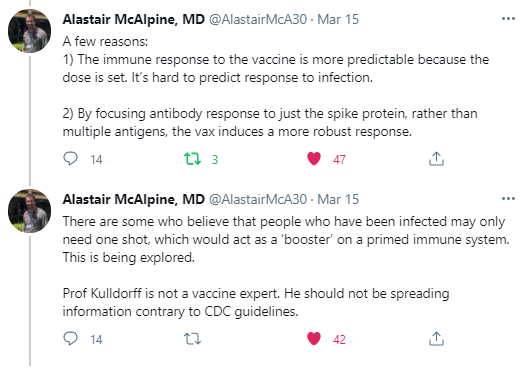
12/Y
For herd immunity, we want antibodies + B cells / plasma cells that prevent re-infection; i.e. we want neutralizing antibodies that cause sterilizing immunity.
(If any non-expert says, "but T cells!!" to you, ignore them
sciencedirect.com/science/articl…
For herd immunity, we want antibodies + B cells / plasma cells that prevent re-infection; i.e. we want neutralizing antibodies that cause sterilizing immunity.
(If any non-expert says, "but T cells!!" to you, ignore them
https://twitter.com/AtomsksSanakan/status/1341870231027920903)
sciencedirect.com/science/articl…
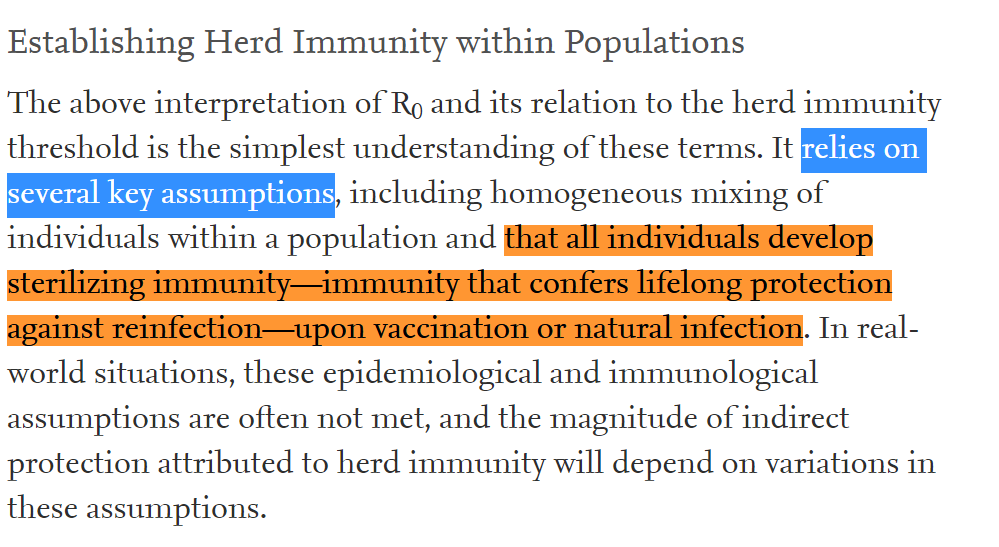
13/Y
Unfortunately:
- not all antibodies are neutralizing
- neutralizing antibodies can wane, allowing for re-infection
- SARS-CoV-2 mutations could evade antibodies, or result in a more contagious form needing more people immune for herd immunity
Etc.
Unfortunately:
- not all antibodies are neutralizing
- neutralizing antibodies can wane, allowing for re-infection
- SARS-CoV-2 mutations could evade antibodies, or result in a more contagious form needing more people immune for herd immunity
Etc.
https://twitter.com/AtomsksSanakan/status/1384036645918310402
14/Y
Vaccines can help with this by increasing levels of neutralizing antibodies or addressing variants (see part 11/Y).
Conversely, allowing many infections facilitates the evolution of harmful mutants.
medrxiv.org/content/10.110…

Vaccines can help with this by increasing levels of neutralizing antibodies or addressing variants (see part 11/Y).
Conversely, allowing many infections facilitates the evolution of harmful mutants.
medrxiv.org/content/10.110…
https://twitter.com/AdamJKucharski/status/1358762039569694725
https://twitter.com/ashishkjha/status/1354995266143875072
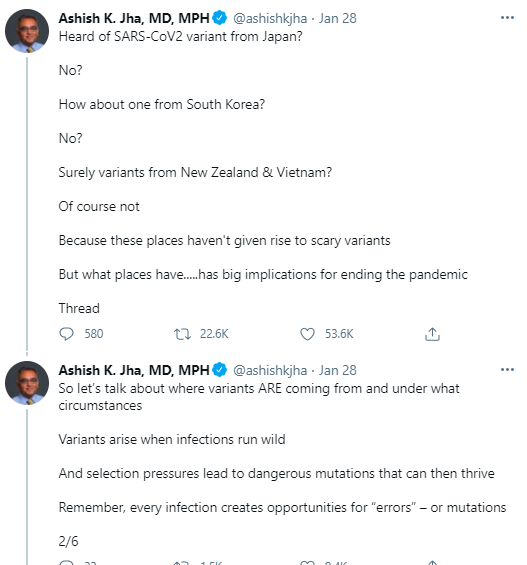
15/Y
So who in their right mind would advocate for taking off brakes to allow for many infections?
Jay Bhattacharya, and his Great Barrington Declaration group.
At this point, he's just sabotaging the brakes for India and pushing the car off the cliff.

So who in their right mind would advocate for taking off brakes to allow for many infections?
Jay Bhattacharya, and his Great Barrington Declaration group.
At this point, he's just sabotaging the brakes for India and pushing the car off the cliff.
https://twitter.com/AtomsksSanakan/status/1368251778114985991
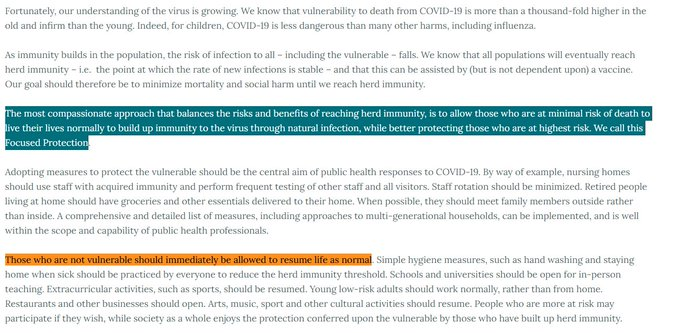
16/Y
But if you're going to push the car off the cliff, you may want to downplay how dangerous that is.
So Bhattacharya reaches into his usual bag of tricks for doing that. For example, citing Ioannidis' work on fatality rates:
theprint.in/opinion/majori…
But if you're going to push the car off the cliff, you may want to downplay how dangerous that is.
So Bhattacharya reaches into his usual bag of tricks for doing that. For example, citing Ioannidis' work on fatality rates:
https://twitter.com/AtomsksSanakan/status/1341187557326004225
theprint.in/opinion/majori…
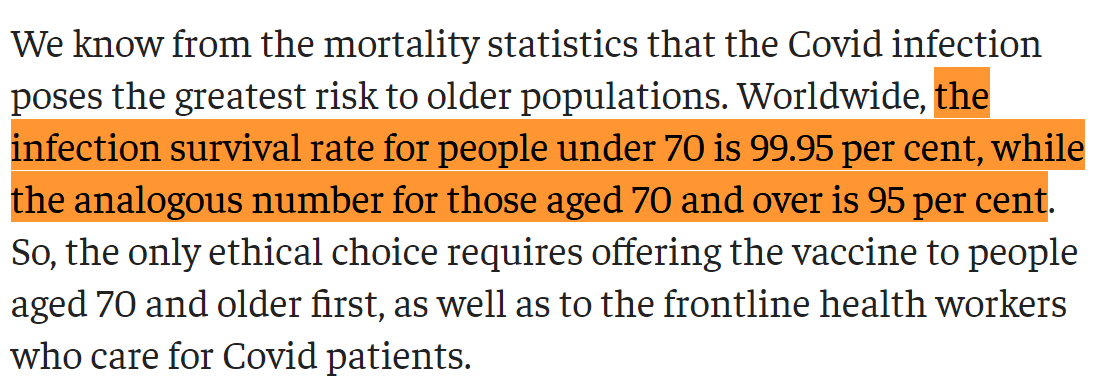
17/Y
But Ioannidis' poor work leads to fatality rates so impossibly low that they require more people are infected than actually exist (Bhattacharya did the same in part 6/Y).
One of the places that happens is... India.

But Ioannidis' poor work leads to fatality rates so impossibly low that they require more people are infected than actually exist (Bhattacharya did the same in part 6/Y).
One of the places that happens is... India.
https://twitter.com/AtomsksSanakan/status/1381473706489356291
https://twitter.com/AtomsksSanakan/status/1369430446271037449
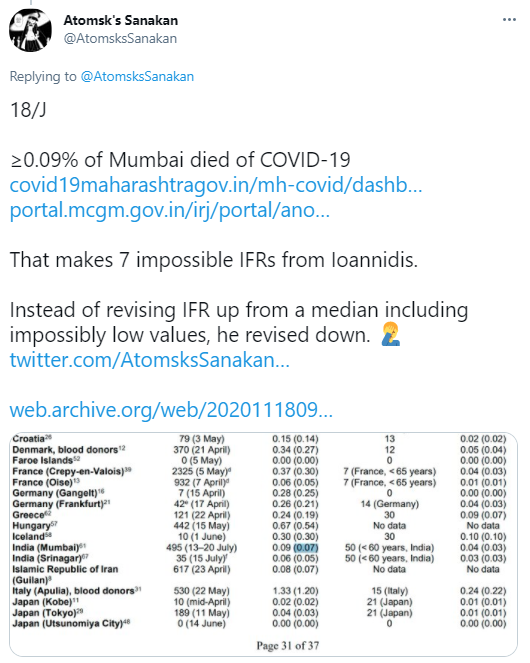
18/Y
And of course, Bhattacharya knowingly abuses the misleading "infection survival rate" framing.
Easy to cover up how bad 600,000 deaths are by saying '99.4% survival rate', without mentioning 100 million infected.

And of course, Bhattacharya knowingly abuses the misleading "infection survival rate" framing.
Easy to cover up how bad 600,000 deaths are by saying '99.4% survival rate', without mentioning 100 million infected.
https://twitter.com/AtomsksSanakan/status/1343610591156568067
https://twitter.com/AtomsksSanakan/status/1341352277890789376
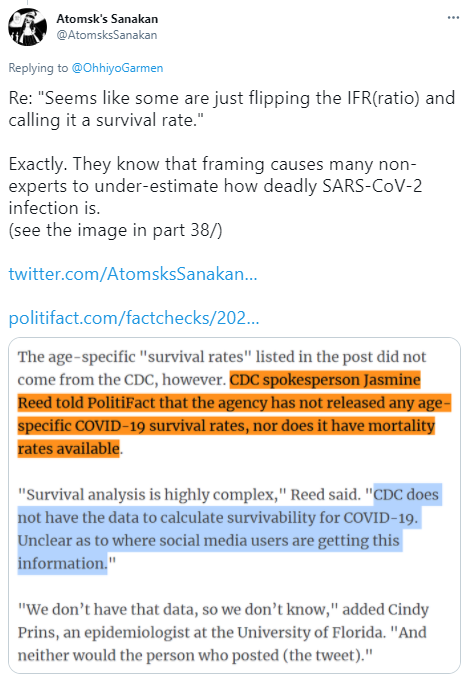
19/Y
As the car progresses on its descent towards the cliff, Bhattacharya downplays the risk to younger people onboard.
Ioannidis' debunked + impossible work makes room for that, as does willfully ignoring better studies
theprint.in/opinion/majori…
As the car progresses on its descent towards the cliff, Bhattacharya downplays the risk to younger people onboard.
Ioannidis' debunked + impossible work makes room for that, as does willfully ignoring better studies
https://twitter.com/AtomsksSanakan/status/1368266601267597312
theprint.in/opinion/majori…
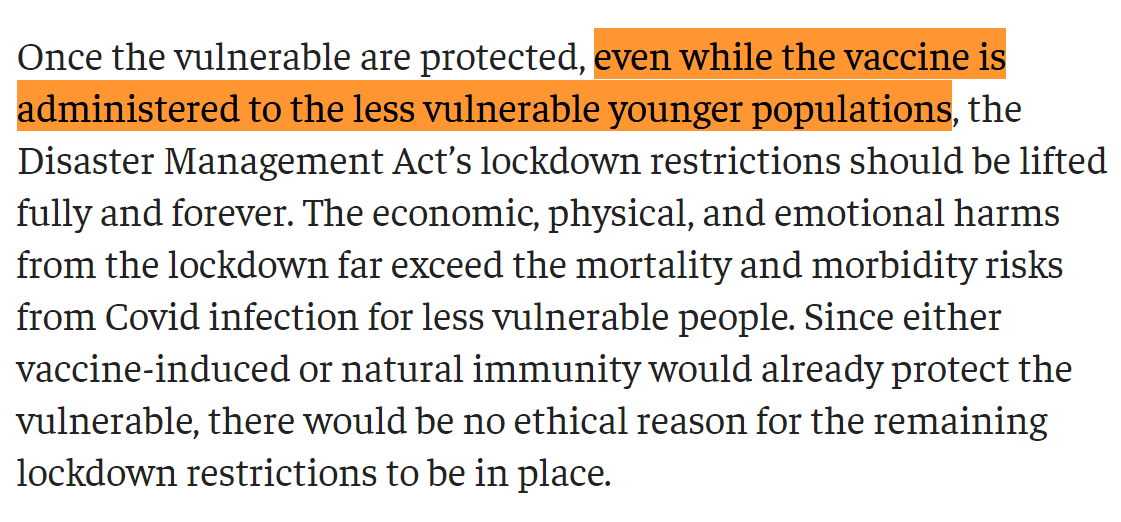
20/Y
Bhattacharya also downplays the risk of sabotaging brakes, by side-stepping how India + other nations under-estimate their number of COVID-19 deaths.
bmj.com/content/372/bm…
medrxiv.org/content/10.110…
github.com/akarlinsky/wor…
theprint.in/opinion/majori…
Bhattacharya also downplays the risk of sabotaging brakes, by side-stepping how India + other nations under-estimate their number of COVID-19 deaths.
bmj.com/content/372/bm…
medrxiv.org/content/10.110…
github.com/akarlinsky/wor…
https://twitter.com/AtomsksSanakan/status/1294251323643265025
theprint.in/opinion/majori…
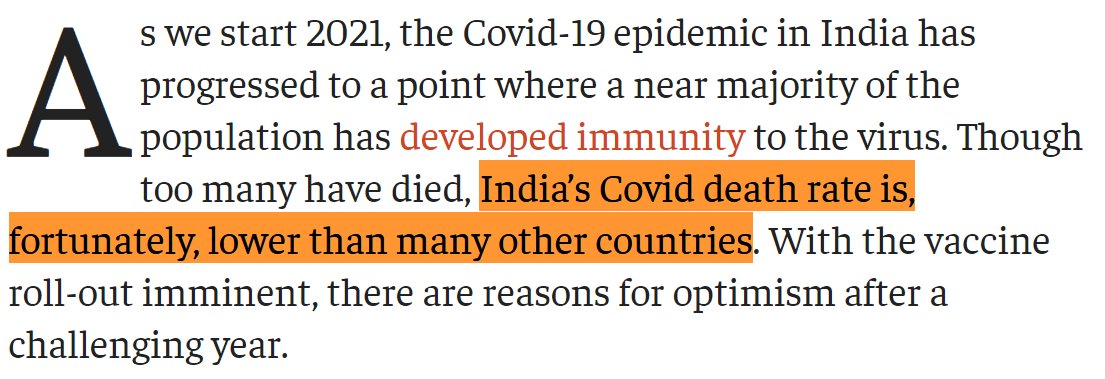
21/Y
The "brakes / cliff" analogy might offend some.
I no longer care. 🙂
I value the feelings of deniers like Bhattacharya less than the lives they put at risk.
Red circle is when Bhattacharya's India article was published:
ourworldindata.org/explorers/coro…
The "brakes / cliff" analogy might offend some.
I no longer care. 🙂
I value the feelings of deniers like Bhattacharya less than the lives they put at risk.
https://twitter.com/GidMK/status/1383374176514232327
Red circle is when Bhattacharya's India article was published:
ourworldindata.org/explorers/coro…
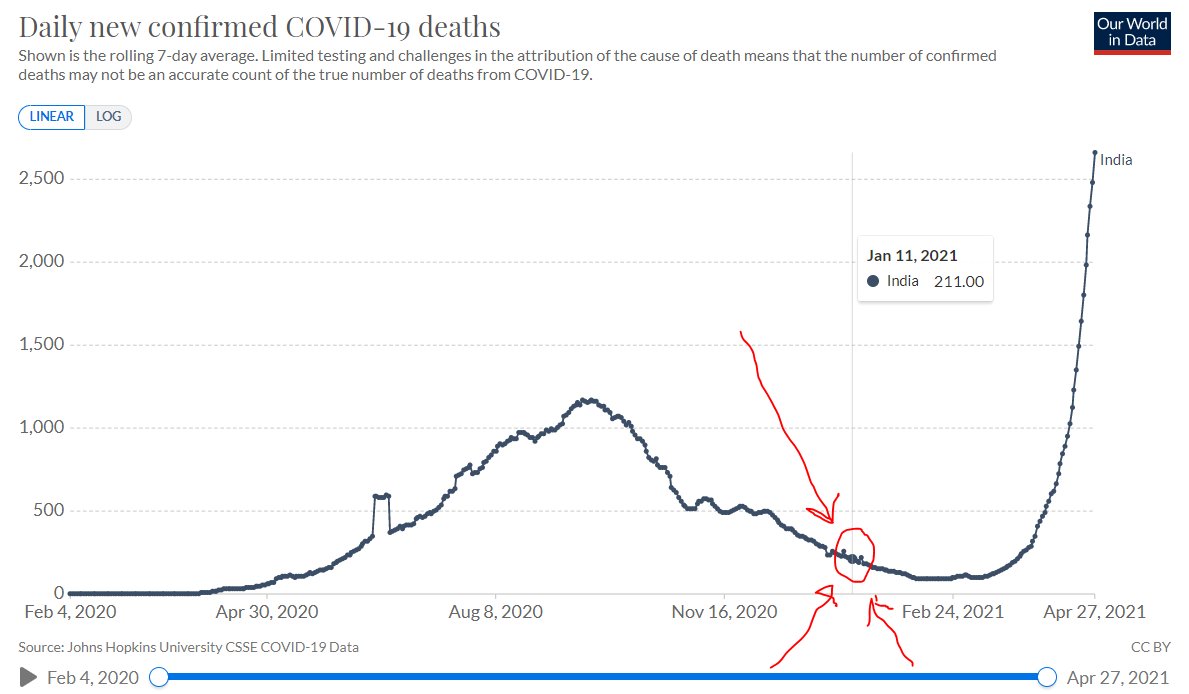
22/Y
On vaccinating infected people (see part 10/Y):
- vaccines help infected folks
- other priorities, like vaccinating the elderly + those in regular contact with the infected (ex: healthcare staff)
- risk of doses expiring waiting to find non-infected
On vaccinating infected people (see part 10/Y):
- vaccines help infected folks
- other priorities, like vaccinating the elderly + those in regular contact with the infected (ex: healthcare staff)
- risk of doses expiring waiting to find non-infected
https://twitter.com/AtomsksSanakan/status/1384256272275439616
23/Y
And Bhattacharya's January 2021 article was in line with horrible advice he's given to India *for months.*
For example, before there was a vaccine he advocated for herd immunity via people getting infected.
July 30, 2020:
techpolicyinstitute.org/2020/07/30/jay…
And Bhattacharya's January 2021 article was in line with horrible advice he's given to India *for months.*
For example, before there was a vaccine he advocated for herd immunity via people getting infected.
https://twitter.com/AtomsksSanakan/status/1283972385608171521
July 30, 2020:
techpolicyinstitute.org/2020/07/30/jay…
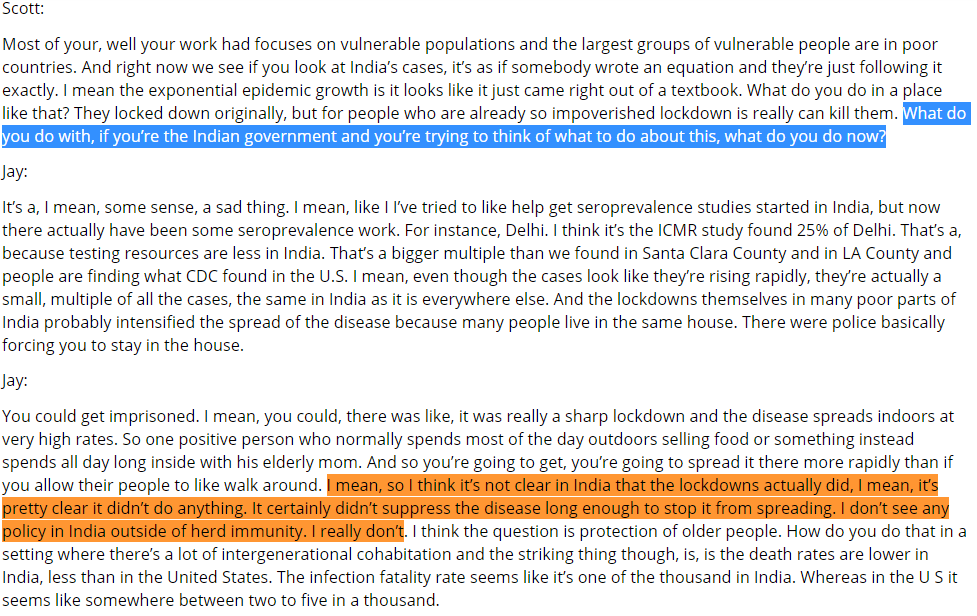
24/Y
Yet Bhattacharya + his Great Barrington Declaration team refuse to admit to they were wrong.
That's in contrast to those with integrity like Monica Gandhi, who apologized for what she said on India + herd immunity.
😡

Yet Bhattacharya + his Great Barrington Declaration team refuse to admit to they were wrong.
That's in contrast to those with integrity like Monica Gandhi, who apologized for what she said on India + herd immunity.
😡
https://twitter.com/gbdeclaration/status/1385675236750802946
https://twitter.com/MonicaGandhi9/status/1384902562688737280
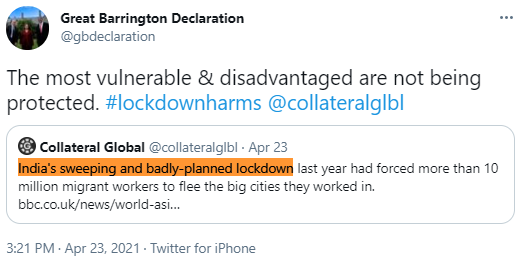
25/Y
The results in 7/Y showing ~24% infected, were out by February 4.
I re-tweeted them on February 10.
So if Bhattacharya bothered to pay attention, he had weeks to correct his dangerous mistake + warn people.
Yet he didn't.

The results in 7/Y showing ~24% infected, were out by February 4.
I re-tweeted them on February 10.
So if Bhattacharya bothered to pay attention, he had weeks to correct his dangerous mistake + warn people.
Yet he didn't.
https://twitter.com/PIBMumbai/status/1357274736108085248
https://twitter.com/AtomsksSanakan/status/1359645888080211977
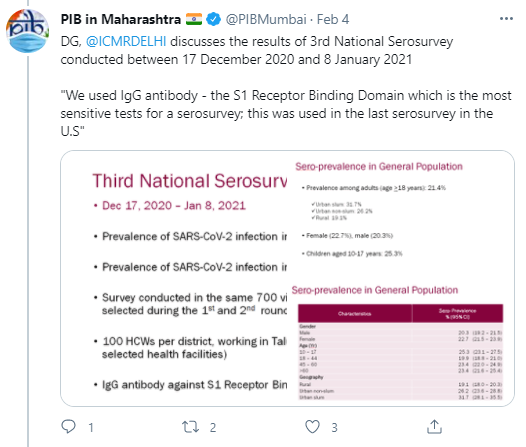
26/Y
So hopefully this thread explained some reasons why so many experts were rightly upset with Jay Bhattacharya.
He's been ludicrously irresponsible during this pandemic.

So hopefully this thread explained some reasons why so many experts were rightly upset with Jay Bhattacharya.
He's been ludicrously irresponsible during this pandemic.
https://twitter.com/bealelab/status/1386088731229265923
https://twitter.com/Kit_Yates_Maths/status/1386604383312486406
https://twitter.com/dgurdasani1/status/1386275256189558787
https://twitter.com/swapneilparikh/status/1372986824486838277

• • •
Missing some Tweet in this thread? You can try to
force a refresh

